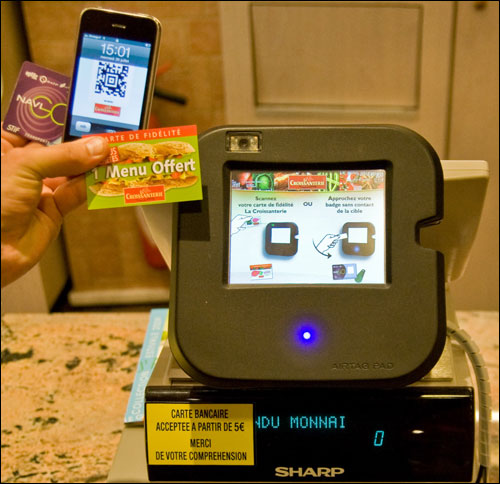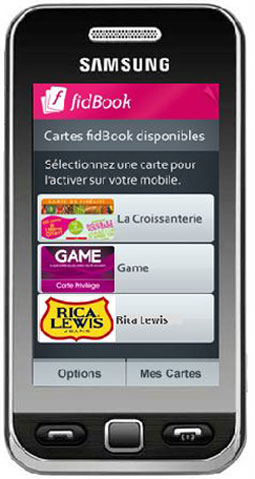Two weeks after the launch of a Near Field Communication (NFC) RFID initiative known as Cityzi, hundreds of Nice residents are using Samsung phones to function as bus and light-rail tickets. They can also employ NFC-enabled cards or phones to gain loyalty points when shopping at participating stores. This portion of the larger Cityzi NFC pilot (which also includes smart posters that provide tourist information about the city, as well as future contactless payment plans) is working well, says Jérémie Leroyer, the CEO of contactless marketing firm Airtag, indicating that while it is still too early to evaluate the success of the contactless transit-ticket and loyalty-card programs, user feedback has been favorable thus far.
Airtag is providing the platform and software to link the unique ID number of each mobile phone’s NFC RFID module with transit-ticketing accounts on the server of rail and bus company Veolia Transport, as well as loyalty programs for area merchants. To date, approximately 10 stores operated by three merchants are participating: La Croissanterie, a fast-food chain; Game, a video store; and Rica Lewis, a jeans retailer. About 4,000 NFC-enabled phones are expected to be sold to participants. In addition, participating stores will provide NFC-enabled loyalty cards that can be used alternatively by those who want to participate in loyalty programs without having to purchase the mobile phone. Like the phone, the loyalty cards will utilize Airtag software to track the cardholder’s purchasing history, and to provide appropriate discounts.

For those using the contactless mobile phones, individuals can first go to one of about five Orange France Telecom stores in Nice, where they can then purchase an NFC-enabled Samsung S5230 touch-screen phone. The phone itself costs less than €10 ($12) when purchased in conjunction with a service contract. Alternatively, consumers can visit one of the other participating mobile service providers: SFR, NRJ Mobile and Bouygues Telecom.
The phone comes with an NFC chip that functions as an RFID reader and tag, as well as a SIM card that stores data related to NFC transactions. In the transit application, users first go to the tram station or bus stop and tap the phone against a contactless reader installed at that location. The Airtag system provides a choice of options, such as viewing account data linked to the unique ID number encoded to the phone’s NFC chip, buying additional tickets or purchasing a monthly pass. If buying tickets, the individual is then presented with a list of options, such as purchasing 10 tickets or more. When he or she makes a selection, the system approves the transaction, and the purchase price is then charged to the user’s mobile service provider account. The customer is later billed by that service provider for the amount due. In that way, no credit card or cash is necessary.
Upon boarding a bus or train, the user taps the phone against a contactless reader, and if he or she has a monthly pass, the ride is simply approved, while if that individual has prepaid for a specified number of rides, that ride is then deducted from the balance of tickets available on the phone’s memory. The next time the phone is used at a fixed NFC contactless reader, the updated information is also transmitted to the wireless service provider’s server.
For the loyalty application, known as FidBook (Fid is short for fidélité, the French word for loyalty), the phone can be utilized to collect and redeem loyalty points. First, the user downloads loyalty-card data for a specific merchant at the store entrance, by tapping the phone on a smart poster containing an embedded NFC tag. This opens an “enrollment page” from that merchant’s server on the user’s phone, and he or she can them input any necessary personal data by following the prompts. “This fast enrollment process is a huge benefit for the merchant,” Leroyer says, “as it saves him all the paperwork of the traditional loyalty program enrollment process.”
Once enrolled, the user can tap his or her phone at the contactless terminal installed at the point of sale (POS) of the three merchant chains, at the time a purchase is being made. Although the Cityzi program will eventually include contactless payment functionality, it currently does not, so users must pay for purchases using cash or a credit card. When the cardholder taps the phone against the reader, sales data is linked to the unique ID number on that phone, along with the user’s FidBook account number, in the store’s back-end server. When the user has reached a pre-specified amount of purchases, he or she can receive a free product (a free meal after spending €30, for instance.)
The system allows phones to connect to Airtag’s NFC portal, enabling users to load dozens of loyalty applications—which the company calls “Services Widgets”—onto their handset. By the end of the summer, Airtag hopes to install NFC POS readers at 50 to 60 merchant locations throughout Nice.
The Cityzi program also includes information services for tourists in the old city of Nice, and is expected to allow contactless payments in the future. The system went live on May 21, after being piloted in Nice for the past year. The project is coordinated by the Association Francaise pour le Sans Contact Mobile (AFSCM), a non-profit group established by France’s three mobile network operators (Orange, Bouygues Télécom and SFR) to boost adoption of NFC and contactless technologies. The goal, Airtag reports, is to expand the Cityzi concept throughout the nation as early as 2011, if it proves to be well received by consumers and merchants in Nice.



